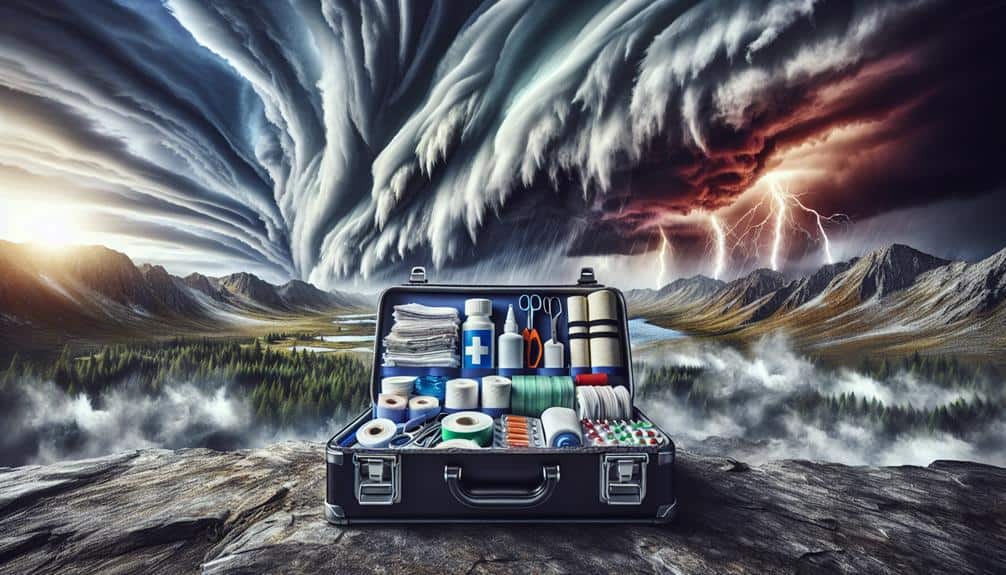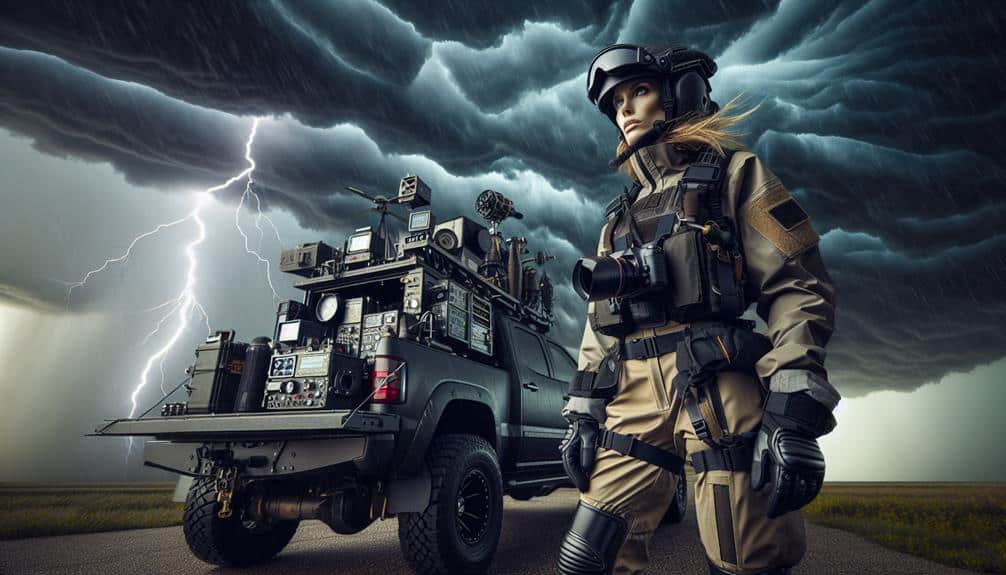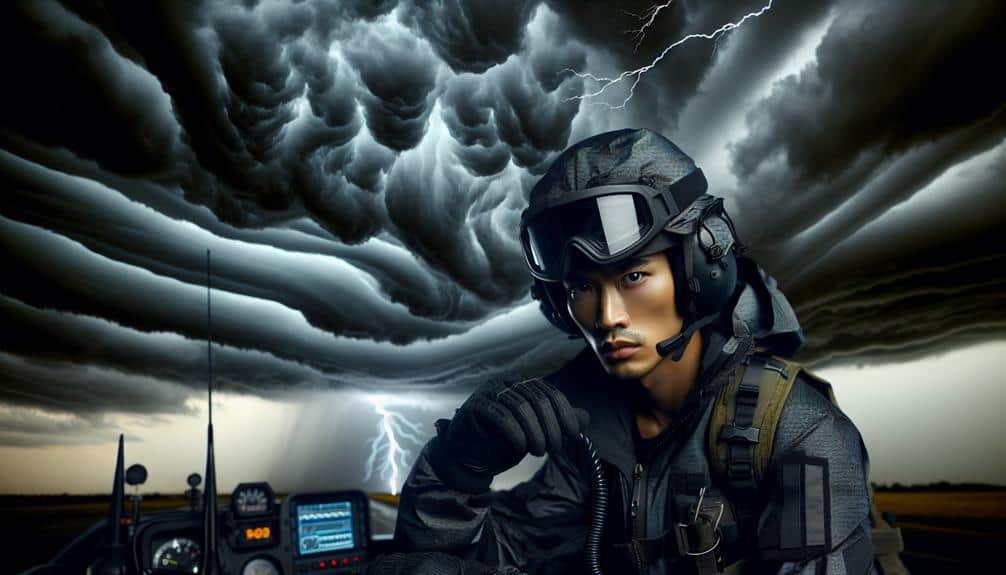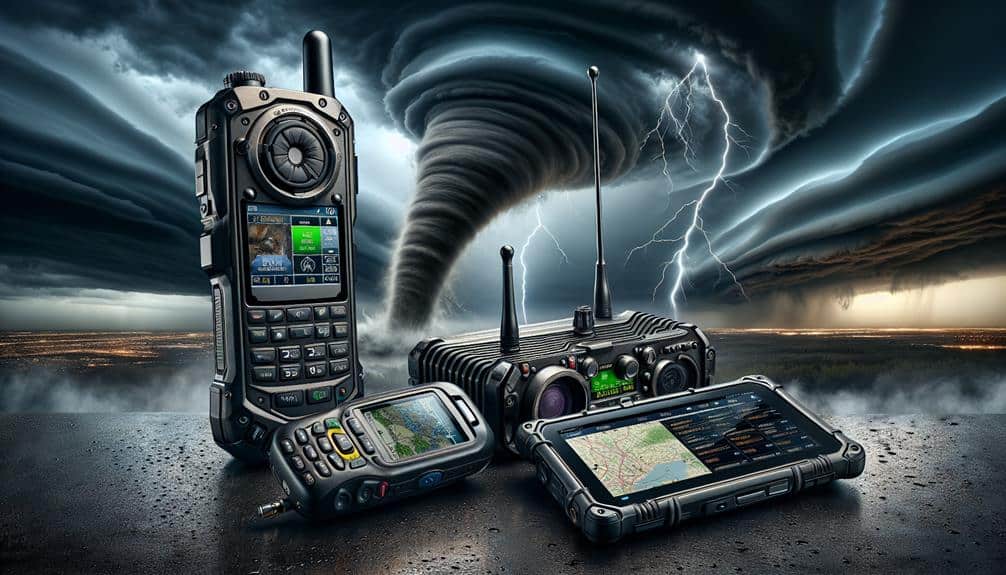As high-wind storm chasers, we prioritize gear that combines durability and advanced materials. We choose helmets from polycarbonate or carbon fiber for high-velocity impacts, and wear waterproof jackets and insulated gloves with adjustable features for changing conditions. Polarized lenses or shatterproof visors protect our eyes. Two-way radios with DMR technology guarantee clear communication, while satellite devices provide GPS tracking and real-time updates. First aid kits with hemostatic agents and thermal blankets prepare us for injuries. Our shelters, whether reinforced dome tents or inflatable shelters, withstand winds up to 80 mph, ensuring safety in extreme conditions. Learn more for detailed information and tips.
Key Points
- High-velocity impact helmets with polycarbonate or carbon fiber composites for exceptional durability and adjustable padding for comfort.
- Waterproof, wind-resistant jackets with insulated gloves and adjustable hoods for versatile protection in changing conditions.
- Two-way radios with DMR technology and long-lasting lithium-ion batteries for clear communication in high-wind environments.
- Reinforced dome tents with aerodynamic shapes and ripstop nylon seams to withstand winds up to 70 mph.
Helmets and Head Protection
Effective head protection, particularly helmets designed to withstand high-velocity impacts, is vital for storm chasers operating in high-wind environments. We're not just talking about any helmet; we need ones with exceptional impact resistance and durability. High-velocity debris can turn into deadly projectiles, and our helmets must be able to absorb these forces efficiently. Advanced materials like polycarbonate and carbon fiber composites are often used in constructing these helmets due to their high tensile strength and shock-absorbing properties.
But let's not overlook ventilation and comfort. When we're out in the field for hours, a helmet that traps heat and causes discomfort can be more of a hindrance than a help. Modern storm-chasing helmets incorporate strategically placed ventilation channels that maximize airflow without compromising structural integrity. This balance guarantees that we stay cool and focused, even in sweltering conditions.
Moreover, adjustable padding and ergonomic designs guarantee that helmets fit securely and comfortably, accommodating a range of head sizes and shapes. This tailored fit is essential because a poorly fitting helmet can reduce its protective capabilities. Essentially, the right helmet not only safeguards our heads but also enhances our overall storm-chasing experience.
Wind-Resistant Clothing
Wind-resistant clothing is necessary for storm chasers, providing a barrier against high-velocity winds and flying debris while maintaining mobility and comfort. When we're out there facing the elements, the right gear makes all the difference. High-quality waterproof jackets are a fundamental component of our wardrobe. These jackets, often featuring advanced materials like Gore-Tex, act as a shield against torrents of rain and harsh winds. They typically include sealed seams and zippers to prevent water ingress, ensuring we stay dry and focused.
Equally important are insulated gloves. Designed to retain warmth without compromising dexterity, these gloves are essential when handling equipment in frigid conditions. Look for gloves with synthetic insulation, which provides excellent thermal efficiency even when wet. Reinforced palm areas also enhance grip, a crucial feature when gripping instruments in stormy weather.
Wind-resistant clothing must balance protection and flexibility. Jackets with adjustable hoods and cuffs allow us to customize the fit, minimizing wind penetration. Additionally, layering systems provide versatility; we can adapt quickly to changing conditions by adding or removing layers.
In this line of work, where every decision impacts our safety and performance, investing in top-tier wind-resistant clothing is non-negotiable.
Eye Protection
Proper eye protection is fundamental for storm chasers, shielding our eyes from debris, intense wind, and precipitation. When we're out in the field, sunglasses with polarized lenses reduce glare and enhance visual clarity, essential for spotting storm patterns. However, during high-wind events, sunglasses alone may not be sufficient.
Goggles provide a superior seal against wind-driven particulates. Opt for models with anti-fog coatings and impact-resistant polycarbonate lenses. This guarantees unobstructed vision and durability under extreme conditions. Safety glasses are another viable option, offering a combination of protection and comfort. For those of us who wear prescription lenses, safety glasses with prescription inserts provide clear vision without compromising safety.
Visors attached to helmets or hats can offer additional protection from horizontal rain and flying debris. Look for visors made from shatterproof materials, such as polycarbonate, to enhance safety.
Selecting the right eye protection gear isn't just about comfort; it's about safeguarding our most vital sense. By using sunglasses, goggles, safety glasses, and visors, we can secure clear visibility and protect our eyes from the elements. This enables us to focus on the excitement of the chase while maintaining our safety.
Communication Devices
When storm chasing, we must prioritize reliable communication to guarantee safety and coordination. Two-way radios with a range of up to 30 miles and satellite communication devices offering 99% global coverage are essential.
These tools help us maintain contact with team members and emergency services, even in remote areas.
Reliable Two-Way Radios
Two-way radios are vital for storm chasers, offering reliable communication in high-wind conditions when cellular networks often falter. We need devices that can withstand harsh environments while guaranteeing our messages are transmitted clearly and promptly.
Key considerations for our radios include battery life and signal strength, both of which are essential for maintaining contact over extended periods and through severe weather. Battery life is paramount; our radios must operate for hours without needing a recharge. Lithium-ion batteries, providing high energy density and extended longevity, are the preferred choice.
For example, models like the Motorola XPR 7550e provide up to 29 hours of battery life on a single charge, ensuring we remain connected during prolonged chases. Signal strength is equally important. We often find ourselves in remote areas where terrain and atmospheric conditions can impact communication.
High-power output radios, typically around 5 watts, guarantee robust signal penetration. Features like Digital Mobile Radio (DMR) technology further enhance clarity and reduce interference. The Kenwood NX-5300, for instance, offers superior signal strength and digital clarity, making it a reliable choice.
Satellite Communication Devices
For storm chasers, satellite communication devices offer an important backup for maintaining connectivity when traditional communication methods fail. These devices guarantee that we remain connected, even in the most remote and challenging conditions. Utilizing satellite networks, they provide robust GPS tracking, enabling us to accurately monitor our location and navigate high-wind areas with precision.
Real-time weather updates are crucial for storm chasers. Satellite communication devices offer continuous data streams, giving us the edge to make informed decisions swiftly. Unlike cellular networks, which are often disrupted during severe weather conditions, satellite devices maintain a reliable connection. This constant communication link is essential, allowing us to receive alerts and share our findings promptly.
When it comes to safety, redundancy is key. Satellite communication devices serve as a crucial layer of security, guaranteeing that our team can communicate effectively, regardless of the circumstances. The integration of GPS tracking with weather updates ensures that we've detailed situational awareness, reducing risks and enhancing our ability to respond to rapidly changing conditions.
In essence, satellite communication devices empower us with the freedom to chase storms confidently, knowing we've a dependable connection and access to important data when we need it most.
First Aid Kits

Ensuring our first aid kits are stocked with essential medical supplies is important for addressing injuries during high-wind storm chasing. We need to anticipate a range of potential injuries, from minor abrasions and contusions to more severe traumas such as fractures and deep lacerations.
Our kits should contain a complete array of emergency supplies, including sterile gauze pads, adhesive bandages of various sizes, and antiseptic wipes. To manage severe bleeding, we need hemostatic agents and tourniquets.
Moreover, our medical equipment must include instruments like tweezers and scissors, as well as splints and triangular bandages for immobilizing injured limbs. For pain management, over-the-counter analgesics such as ibuprofen and acetaminophen are essential. Including a thermal blanket is crucial for preventing hypothermia in case we find ourselves exposed to the elements for extended periods.
Precise, data-driven decision-making in assembling our first aid kits will enhance our resilience and readiness. By prioritizing high-quality emergency supplies and medical equipment, we ensure we're prepared for a wide array of scenarios. This proactive approach not only optimizes our safety but also empowers us to maintain the freedom to chase storms with confidence and capability.
Emergency Shelters
When high-wind conditions escalate, having access to robust emergency shelters is essential for our safety and survival. We need shelters that aren't only durable but also portable and easy to deploy.
Here are our top three picks:
- Reinforced Dome Tents
- Shelter options: These tents offer high-wind resistance due to their aerodynamic shape and reinforced poles.
- Durability: Made from ripstop nylon and reinforced seams, they withstand winds up to 70 mph.
- Size, portability: Compact and lightweight, typically weighing under 10 pounds, making them perfect for quick setups and transport.
- Inflatable Shelters
- Shelter options: Advanced inflatable designs provide stability and fast setup times, making them ideal for sudden storms.
- Durability: Constructed from high-grade PVC, these shelters can endure wind speeds of up to 60 mph.
- Size, portability: When deflated, they fold into a small package, easily fitting into a backpack.
- Collapsible Storm Shelters
- Shelter options: Featuring rigid frames and heavy-duty fabric, these shelters are engineered for extreme conditions.
- Durability: Tested to resist winds reaching 80 mph, they offer maximum protection.
- Size, portability: These shelters are bulkier but can be transported in larger vehicles, providing a balance between protection and transportability.
These shelter options provide the durability, size, and portability we need to stay safe during high-wind storm chasing adventures.
Frequently Asked Questions
What Type of Footwear Is Best for High-Wind Storm Chasers?
We recommend footwear with high durability and excellent traction for high-wind storm chasing. Prioritize shoe comfort and breathability to guarantee efficiency and freedom. Data shows that rugged, breathable boots provide peak performance in extreme conditions.
Are There Specific Gloves Recommended for Handling Debris During Storms?
Yes, we recommend cut-resistant gloves with reinforced palms for handling debris during storms. Pair them with protective eyewear and heavy-duty boots to guarantee maximum safety and mobility. Always choose gear that prioritizes durability and flexibility.
How Can Storm Chasers Protect Their Electronics From Water Damage?
How can we chase storms and protect our electronics from water damage? We use waterproof cases and protective bags, both tested to withstand extreme conditions. This gear guarantees our devices remain functional, allowing us to continue our pursuit of freedom.
What Are the Best Portable Power Sources for Storm Chasers?
For portable power sources, we recommend solar panels and generators. Emergency shelters can house charging stations powered by these devices, ensuring reliable energy. Solar panels offer renewable energy, while generators provide consistent power during cloudy conditions.
Are There Any Recommended Apps for Real-Time Weather Updates and Alerts?
We've discovered the ultimate lifeline! For real-time weather updates and alerts, RadarScope and WeatherBug Elite excel. These apps provide precise lightning detection and emergency shelters info, ensuring we stay safe and informed during our adventures.


